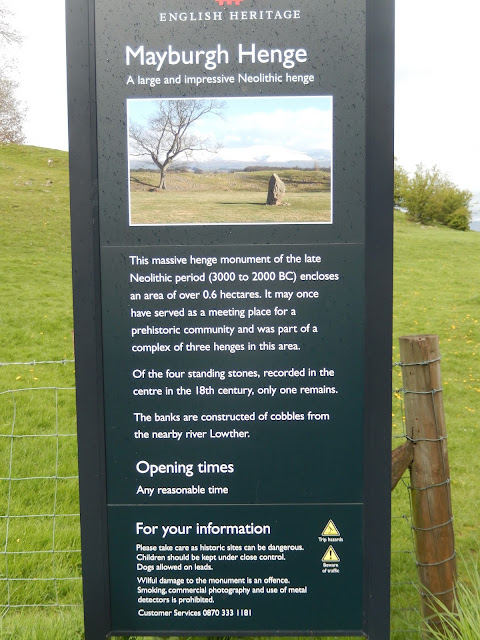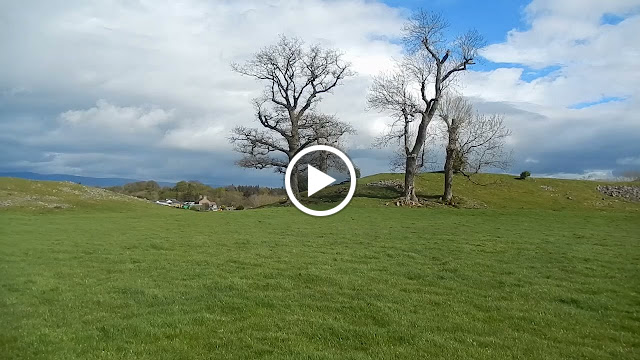Haia Pawb
After our visit to Long Meg and Her Daughters, Grevel drove us back towards our night's accommodation in Grasmere, but not before we stopped off at three more interesting sites in Cumbria.
Our first site was the Mayburgh Henge, 1.5 miles south of Penrith. As explained on the English Heritage information board, this henge was apparently built in the Neolithic period (2000-3000 BC). The banks, which are up to ten feet high and more, were built using cobble stones collected from a nearby river. The henge was likely a meeting place for local tribes, possibly for the trading of stone axes, and is part of a complex of sites in the area. The other sites are King Arthur’s Round Table, only 400 metres away, and Little Round Table, which is no longer visible. In the centre of the henge is a large monolith, nine feet high, one of four that were reported to exist in the 18th century. Apparently another four large stones were removed from the entranceway around about the same time.
 |
| The English Heritage information board |
 |
| A view of the henge bank from the centre |
 |
The henge, showing the standing stone in the centre
and the pebbles forming the banks |
 |
| A video of the henge, taken from the centre, starting at the entrance |
 |
| The standing stone in the middle of the henge |
A short walk down the road, which for us was in drizzle, is King Arthur's Round Table, another Neolithic henge, dating from 2000 BC, but believed much later to have been King Arthur's jousting area. The henge is around 90 metres in diameter and is comprised of a ditch that encloses a flat area and a raised circular platform, possibly used for gatherings of local tribes. An earthen bank, 16 metres wide, surrounds the ditch and appears to have two entrances, though only the south-east entrance survives, the northwest entrance having been mostly destroyed by the nearby modern road.
Two standing stones were reported in the mid-17th century to be on either side of the north-west entrance, but these had disappeared by 1725. The entrances were most likely built to align with the winter solstice sunrise (south-east) and the summer solstice sunset (north-west), though of course the true intentions of the Neolithic peoples are almost impossible to discern. Possibly because the site was so close to houses, roads, and motorways, I didn't feel the awe that I have felt at other sites.
 |
| Nearby information board |
 |
| Part of the interior of the henge |
 |
| The raised platform inside the henge |
 |
| The ditch and the bank around the raised platform |
 |
Grevel on the raised platform, the houses beyond
showing the road that cut the NW entrance |
We then travelled almost due west through Keswick (pronounced Kes-ick) to the Castlerigg Stone Circle. This amazing site, which dates back to the Neolithic period (4000-5000 years ago), comprises 38 standing stones, some almost 10 feet high, and is situated on a plateau in a natural amphitheatre, with 360 degree views of the surrounding fells. Some of the tallest peaks in Cumbria, for example, Helvellyn and Skiddaw, can be seen from the site, which itself may have been used as a trading post and/or an astronomical observatory, with the stones aligned to the sun, moon and stars. I couldn't help but be awe-struck by the wind-swept, mysteriously constructed and arranged stones and shapes, and by the sweeping views.
 |
| On-site model of Castlerigg |
 |
| Information board |
 |
Half the circle, taken from near the 'Sanctuary',
the set of stones forming a rectangle inside the circle |
 |
| The other half of the circle, taken from the same spot |
 |
Video of Castlerigg, showing the circle, the surrounding mountains,
and other visitors (human and sheep) |
 |
| Mood shot, taken just before we left |
As we drove from Castlerigg to Grasmere, the valleys and mountains we passed through reminded me of the landscape along the road between Corris and Dolgellau in Wales.
 |
A view of the Cader Idris range, which lies
on the road between Corris and Dolgellau |
No wonder I felt at home, for Corris used to be a slate mining village and the Lake District is the only other source of slate in the UK. If you look at roof slate on UK homes, a purple-blue tinge means its from Wales, while a green hinge means it's from the Lakes.
We arrived at How Foot Lodge in Grasmere early in the evening. The B&B is near the 'foot' of the How stream and is only a couple of doors down from Dove Cottage, where William Wordsworth and his sister, Dorothy, lived from December 1799 to May 1808.
 |
| How Foot Lodge |
 |
| Dove Cottage |
 |
View of 'The Lion and the Lamb, the profile of Helm Crag,
a fell (a high barren landscape feature)
seen from our bathroom window |
After checking in and cleaning up, we went to Tweedies Bar in the Dale Lodge Hotel a pleasant 10 minute walk away. We had a delightful meal topped off with single malt whiskies.
 |
| Night sky before dinner |
 |
| Night sky after dinner |
Later in the evening, we changed back into our outdoor gear and walked to White Moss Common, passing the pool where Wordsworth allegedly saw the leech-gatherer that inspired his poem. We then climbed the ridge to the one vantage point where both Grasmere and Rydal Water can be seen. Unlike the wild goats we disturbed on both the way up and the way down, our footing wasn't as sure. After several stumbles and backside slides and guesses of direction in the cloud-thatched dark, we found the track back to Grasmere and a well-deserved rest after an enthralling day.
 |
A coffin stone/resting stone on the Corpse Road
between Ambleside and Grasmere |
In the morning, we visited St Oswald's Church graveyard to pay homage to William and Dorothy.
 |
| Gravestone of William Wordsworth and his wife, Mary |
 |
| Gravestone of Dorothy Wordsworth |
After this, we bought packets of the 'best gingerbread in the world', available from The Grasmere Gingerbread Shop, which is next door to the church. We headed back to Manchester, for Grevel to prepare for a weekend writing workshop and for me to travel on to Ynys Mon (Anglesey) to continue my research. (More about this is future blog postings.)
My thanks go to Grevel and his wife, Amanda, for their hospitality during my stay in Manchester and to Grevel himself for sharing his knowledge and love of British indigenous sites. My travels with him during my two research trips to the UK have led to incredible experiences of the magic and mystery in the landscape and the sacred endeavours of our ancestors.
 |
| View from my bedroom window, The Harbour Hotel, Cemaes Bay, Ynys Mon |
By the way, when I changed the name of the blog, the email notification process that some of you accessed seemed to stop working. I’ve set up the process again using the new name, so if you wish to receive notification of new postings, please register using the ‘Follow by Email’ section on the right hand side of the blog. Thanks.
All comments are welcome.
Cofion cynnes
Earl























